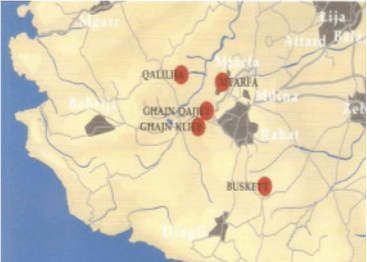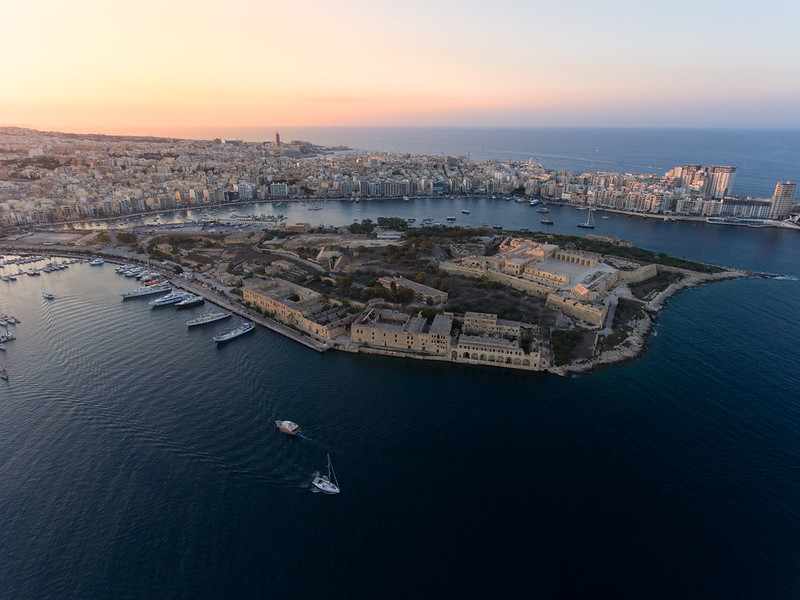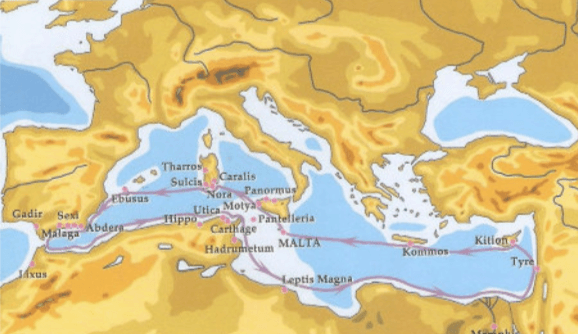| Malta Short Let: Cozy Stay in Gzira | |
|
Sliema Area Modern Designer Finished 2 Bedrooms + Games Room. First floor with Maltese Balcony Large back Terrace with swinging sofa Fully Airconditioned + Full Kitchen 3 TVs, including 65” with backlight. |
 |
|
Book Now: Google Travel | Direct (Cheapest) | Booking.com | Airbnb |
|
Have you ever wondered about the ancient civilizations that once thrived on the islands of Malta? Let’s embark on a fascinating journey through time and uncover the Phoenician footprints etched across this Mediterranean gem.
The Geographic Charm of Malta
Nestled in the heart of the Mediterranean Sea, Malta is more than just a sun-soaked holiday destination. This archipelago—comprising Malta, Gozo, and Comino—sits strategically between Sicily to the north and the African coast to the south. Its prime location made it a crossroads for ancient civilizations, attracting traders, sailors, and settlers for millennia.
The islands boast natural harbors and rugged coastlines, making them ideal pit stops for ancient mariners. Beyond its picturesque landscapes, Malta holds secrets of bygone eras waiting to be explored.
The Phoenician Footprint: A Historical Overview
Around the 8th century BCE, the Phoenicians—renowned seafarers from the Eastern Mediterranean—set their sights on Malta. Drawn by its strategic location, they established settlements to serve as crucial waypoints along their expansive trade routes, which stretched from the Levant to the western edges of the Mediterranean.
Initially, the Phoenicians used Malta as a maritime base, leveraging its excellent harbors to shelter their ships during long voyages. Over time, they began to settle, integrating with the sparse local population and leaving an indelible mark on the islands’ culture and history.
Despite limited natural resources and arable land, the Phoenicians saw value in Malta’s position. It allowed them to control trade networks and safeguard their maritime interests against rival powers, particularly the Greeks, who were expanding their influence in nearby Sicily.
The Punic Period: Continuation and Evolution
As time progressed, Malta transitioned into the Punic period, especially after the decline of Phoenician city-states and the rise of Carthage—a Phoenician colony in North Africa that grew into a formidable power. Under Carthaginian influence, Malta continued to thrive as a strategic outpost. The Punic period saw the evolution of Phoenician culture on the islands, blending with local traditions and laying foundations that would persist even after the Roman conquest in 218 BCE.
Despite Roman rule, the Punic culture remained resilient. Evidence suggests that Punic languages and religious practices continued well into the Roman period, showcasing the deep-rooted influence of the Phoenicians on Malta’s heritage.
Traces of Phoenician Culture in Malta
Language and Legacy
One of the enduring legacies of the Phoenicians in Malta is their influence on the local language and culture. While much of the Phoenician language has been lost to time, inscriptions and artifacts unearthed across the islands hint at their linguistic impact. These discoveries provide valuable insights into the ancient scripts and dialects that once resonated in Malta.
The Maltese language, while primarily rooted in Arabic due to later conquests, may carry echoes of ancient Phoenician dialects. Some place names and terms could potentially trace back to Phoenician origins, illustrating a linguistic tapestry woven over centuries.
The DNA Connection
Recent genetic studies suggest that modern Maltese people may carry genetic markers tracing back to Phoenician ancestors. This fascinating connection bridges the ancient past with the present, highlighting how the movements of early civilizations have shaped contemporary populations.
A study published in “The American Journal of Human Genetics” found that certain Y-chromosome lineages in Maltese men are shared with Lebanese populations, indicating a genetic link to the ancient Phoenicians. This genetic heritage underscores the lasting impact of the Phoenician presence on the islands.
Astarte Worship: The Goddess of Malta
Central to understanding Phoenician culture is the worship of Astarte, the goddess of fertility, love, and war. Astarte was one of the principal deities in the Phoenician pantheon, often associated with the planet Venus. Her worship was widespread across Phoenician colonies, and Malta was no exception.
At the Temple of Tas-Silg near Marsaxlokk, archaeological excavations have uncovered layers of worship spanning from the Neolithic period through the Phoenician and Punic eras, and even into Roman times. This site was a significant religious hub where the Phoenicians dedicated offerings to Astarte.
Artifacts such as figurines, inscriptions, and votive objects found at Tas-Silg provide valuable insights into the religious practices and rituals performed. The temple’s architecture, with its altars and sacred enclosures, reflects the typical Phoenician style, emphasizing the goddess’s importance in daily life and spirituality.
Understanding Astarte’s role enriches our appreciation of the cultural and religious dynamics in ancient Malta. Her worship illustrates the syncretism that occurred as the Phoenicians integrated with local populations, blending their deities and rituals.
Where to stay on your visit to Malta
A 1-bedroom apartment in Sliema provides not only a central location but also a true Maltese experience. This fully air-conditioned apartment, located on the second floor, features a charming Maltese balcony where you can enjoy the island’s vibrant atmosphere. The apartment is ideal for remote workers, with separate desk areas and plenty of entertainment, including a 55” backlit TV. The Maltese-themed décor and art give you a real taste of the local culture while you’re comfortably settled in one of Malta’s most sought-after areas.
Alternatively, if you find yourself more drawn to Gzira, a 2-bedroom apartment in Gzira might be perfect for you. This apartment not only offers a convenient location but also a blend of modern comfort and Maltese charm. With a separate games room (featuring table soccer and a blackboard) and multiple desk areas for work, it’s well-suited for families or groups of friends. The apartment also includes a lovely back terrace with a hanging sofa, perfect for relaxing after a day of exploring. Maltese art and décor, along with a cozy electric fireplace and a small book library, make this stay a memorable part of your trip.
Exploring Phoenician Sites in Malta
If you’re a history enthusiast—or simply curious—Malta offers a treasure trove of Phoenician sites that you can explore.

Phoenician Sites in Malta
Mdina and Rabat: The Silent Cities
Perched on a hilltop in central Malta, Mdina, also known as the “Silent City,” along with its suburb Rabat, is steeped in history. These areas were significant during the Phoenician period, serving as inland settlements away from the bustling ports.
Wandering through the narrow streets of Mdina, you can almost feel the echoes of the past. The city’s fortifications and layout reflect layers of history, from Phoenician foundations to medieval ramparts.
Beneath Rabat lies a network of ancient catacombs and tombs, some dating back to the Phoenician era. The St. Paul’s Catacombs are a testament to the burial practices and architectural ingenuity of the time, showcasing rock-cut tombs that were later used by Romans and early Christians.

Phoenician Sites around Mdina
Marsaxlokk and the Temple of Tas-Silg

The charming fishing village of Marsaxlokk, located in the southeastern part of Malta, is not just famous for its colorful boats and bustling market. Nearby lies the archaeological site of Tas-Silg, a multi-period sanctuary significant during the Phoenician and Punic periods.
Tas-Silg was a religious hub where the Phoenicians worshipped Astarte, their goddess of fertility and war. Exploring this site provides a glimpse into the religious practices and architectural styles of the ancient inhabitants.
The temple complex reveals a blend of architectural influences, including megalithic structures and Phoenician additions. The presence of altars, sacrificial areas, and votive offerings indicates the site’s importance. Artifacts such as pottery, figurines, and inscriptions found here enrich our understanding of Phoenician religious life.
For more on exploring Malta on a budget, check out Exploring Malta on a Shoestring: The Ultimate Guide for Solo Travelers.
The Three Cities: Vittoriosa, Senglea, and Cospicua
Across the Grand Harbour from Valletta lie the Three Cities—Vittoriosa (Birgu), Senglea (Isla), and Cospicua (Bormla). Vittoriosa, in particular, holds Phoenician secrets beneath its historic streets.
These cities served as vital maritime hubs. The natural harbors provided safe anchorage for Phoenician ships, and the area became a melting pot of cultures due to constant interaction with traders from across the Mediterranean.
The influence of Phoenician architecture can be seen in the foundations of fortifications and urban layouts. The use of large stone blocks and strategic positioning reflects their engineering prowess and emphasis on defense.
Looking for family-friendly activities? Visit Best Things to Do in Malta with Kids.
Mysteries of Manoel Island

Photo Credit R.I. Pienaar
Manoel Island, nestled within Marsamxett Harbour, is often overlooked by visitors. However, archaeological findings suggest it was a site of Phoenician activity, possibly used for shipbuilding or as a maritime base.
Today, the island offers a mix of history and leisure. Exploring its shores, you can imagine the ancient ships that once docked here. Notably, excavations have unearthed remains of ancient structures and artifacts, including pottery shards and tools, hinting at industrial activities like glass and metalwork.
Zurrieq’s Hidden Gems
The southern town of Zurrieq is home to intriguing archaeological sites. Phoenician tombs have been discovered in the area, indicating the presence of a settled community. The tombs offer insights into the burial practices and beliefs of the Phoenicians in Malta.
These rock-cut tombs, often featuring shaft entrances and chambers, reflect typical Phoenician mortuary architecture. Artifacts found within, such as amulets, jewelry, and pottery, provide clues about the funerary customs and social structures of the time.
The Enigma of Ras Il-Wardija
Over on the island of Gozo, Ras Il-Wardija is a site shrouded in mystery. It’s believed to have been a religious sanctuary used by the Phoenicians. The site’s remote location and the remains of structures carved into the rock hint at its ancient significance.
The sanctuary includes rock-cut features such as altars and cisterns, suggesting ritual use. Its position overlooking the sea could indicate a connection to maritime worship or celestial observations.
San Pawl Milqi and Ras ir-Raheb
These sites are linked to the agricultural practices introduced by the Phoenicians. San Pawl Milqi, meaning “St. Paul welcomed,” is traditionally associated with the shipwreck of St. Paul but has earlier roots. Excavations have revealed remains of a Roman villa built over a Punic farmhouse, indicating continuous occupation and the importance of agriculture.
The Punic farmhouse showcases architectural elements like courtyards and storage facilities, reflecting the rural life and economic activities of the Phoenicians in Malta. Agricultural tools and press installations suggest olive oil and wine production.
Ras ir-Raheb, located on Malta’s western coast, is another site where Punic remains have been found. It underscores the spread of Phoenician influence across the islands. The site includes remnants of a sanctuary and habitation areas, offering a glimpse into both religious and daily life.
Interested in Malta’s hidden trails? Read about Malta’s Historic Water Trail: Springs and Aqueducts.
Comino and the Blue Lagoon
The tiny island of Comino, famous today for its stunning Blue Lagoon, also holds traces of ancient visitors. While less is known about Phoenician activities here, it’s plausible they utilized the island as a stopover or for resource gathering.
Artifacts such as pottery fragments and tools have been found, suggesting transient occupation or use as a strategic point for maritime navigation. The island’s natural resources, including game and wild plants, would have been valuable for sailors and settlers.
For more on Malta’s natural beauty, see Malta Beckons: Your Winter Escape Just Got Easier with Ryanair’s New Routes.
Phoenician Trade Networks: Malta at the Crossroads
Malta’s strategic position made it a vital link in the extensive Phoenician trade networks. The Phoenicians were master traders, dealing in goods that ranged from everyday commodities to luxury items.
Goods Traded
- Textiles: The Phoenicians were renowned for their purple dye, extracted from the murex snail. Maltese harbors facilitated the exchange of dyed fabrics and garments.
- Metals: Tin, silver, and copper were traded, essential for producing bronze and other alloys. Malta acted as a redistribution point for metals sourced from as far as the Iberian Peninsula.
- Glassware: The Phoenicians pioneered glass-making techniques. Artifacts suggest that Malta may have been involved in the production or trade of glass items.
- Olive Oil and Wine: Agricultural products like olive oil and wine were significant trade goods. The introduction of viticulture and olive cultivation in Malta can be attributed to Phoenician agricultural practices.
Connections Across the Mediterranean
Malta connected the Eastern Mediterranean with the West, serving as a hub between Phoenician cities like Tyre and Sidon and their colonies in North Africa, Sicily, Sardinia, and the Iberian Peninsula.
The islands facilitated not just the movement of goods but also ideas, technologies, and cultural practices. This exchange enriched Malta’s own culture, making it a mosaic of influences.
Shipwrecks of Gozo: A Dive into the Past
The waters surrounding Gozo are not just a diver’s paradise for their clear visibility and marine life but also for the submerged remnants of ancient ships.
Specific Locations and Discoveries
- Xlendi Bay: One of the most significant finds is a Phoenician shipwreck discovered off the coast of Xlendi in Gozo. Lying at a depth of around 110 meters, the shipwreck dates back to the 7th century BCE.
- Artifacts Recovered: The wreck has yielded a trove of artifacts, including amphorae of various types, grinding stones, and ceramics from different origins. The amphorae were likely used to transport goods like wine, oil, and other commodities.
Significance in Understanding Maritime Practices
The diversity of the cargo suggests that the Phoenicians engaged in complex trade networks, collecting goods from different regions to trade elsewhere. The ship’s construction and the items aboard provide invaluable information about shipbuilding techniques, trade routes, and economic interactions of the time.
For diving enthusiasts, exploring these underwater sites is like traveling back in time. It’s a unique opportunity to connect with history in an immersive way.
Safety first! Check out Scuba Diving Mistakes in Malta to ensure a safe adventure.
Phoenician Influence on Maltese Architecture
The architectural footprint of the Phoenicians in Malta is subtle yet significant. While many structures have been lost or built over, elements of their architectural style persist.
Fortifications and Urban Planning
- Use of Large Stone Blocks: The Phoenicians employed massive stone blocks in construction, a technique evident in some of Malta’s oldest fortifications.
- Strategic Locations: Settlements were often established on high ground or near harbors, reflecting a strategic approach to defense and trade.
Housing and Religious Buildings
- Rock-Cut Structures: The use of rock-cut tombs and chambers showcases their engineering skills and adaptation to the local geology.
- Temple Architecture: Sites like Tas-Silg reflect a blend of megalithic and Phoenician architectural elements, indicating a fusion of indigenous and imported styles.
These architectural contributions laid the groundwork for subsequent building practices on the islands, influencing Roman, medieval, and even modern structures.
Conclusion
Malta is a mosaic of cultures, with each layer of history adding depth to its rich tapestry. The Phoenician era is a captivating chapter that has left an indelible mark on the islands.
Whether you’re a history buff, an adventure seeker, or someone looking for a unique travel experience, Malta offers a blend of ancient mysteries and modern delights. Walking through ancient sites, diving into crystal-clear waters to explore sunken ships, or simply soaking in the Mediterranean sun—all these experiences await you.
So, next time you plan a getaway, consider delving into the ancient world of Phoenician Malta. You might just find that the echoes of the past make your journey all the more enriching.
Planning a trip? Discover unique accommodations with Airbnb in Malta.
Ready to uncover Malta’s ancient secrets? Come to Malta we have some of the best accommodation the island has to offer . Book today.
Exploring Phoenician Sites in Malta
Whether you’re staying in Sliema or Gzira, you’ll be close to Malta’s rich historical sites. For example, a 1-bedroom apartment in Sliema offers a central location with a Maltese balcony, fully air-conditioned rooms, separate desk areas, and a 55” backlit TV. The apartment is tastefully decorated with local art, providing a cozy and cultural stay right in the heart of Sliema.
If Gzira appeals to you, a 2-bedroom apartment in Gzira provides a fantastic location with modern comforts, including a games room, multiple desk spaces, and a relaxing back terrace with a hanging sofa. Fully air-conditioned and featuring Maltese-themed décor, it’s a great base for exploring with added amenities like a library and an electric fireplace.








